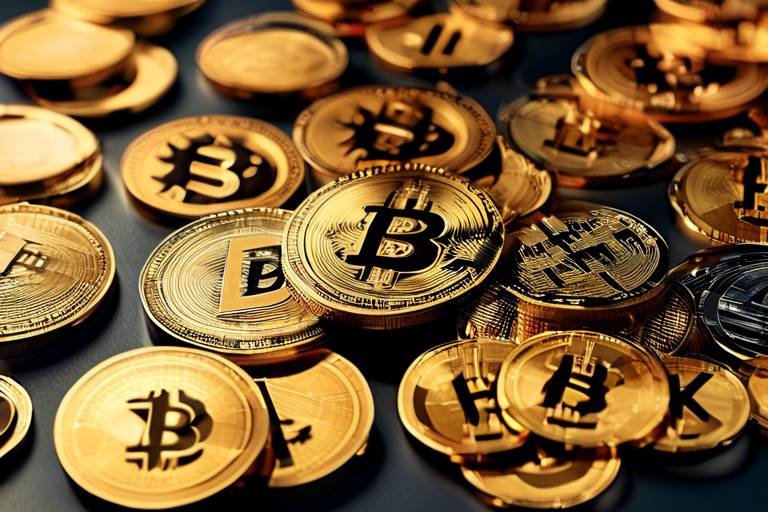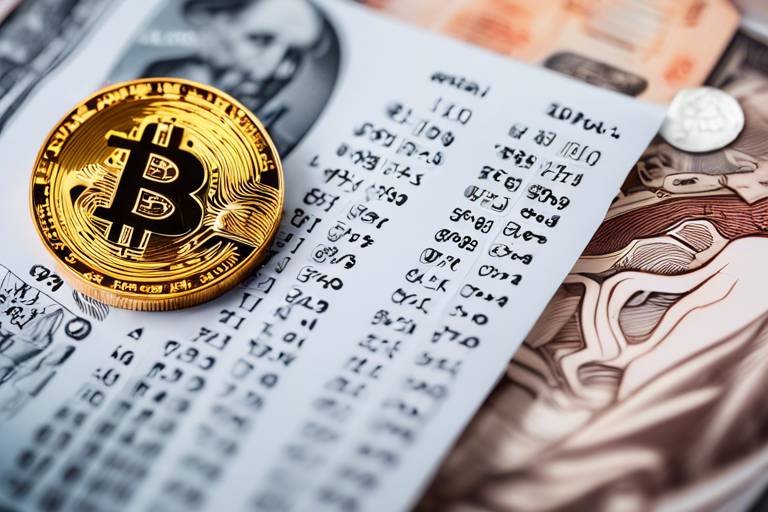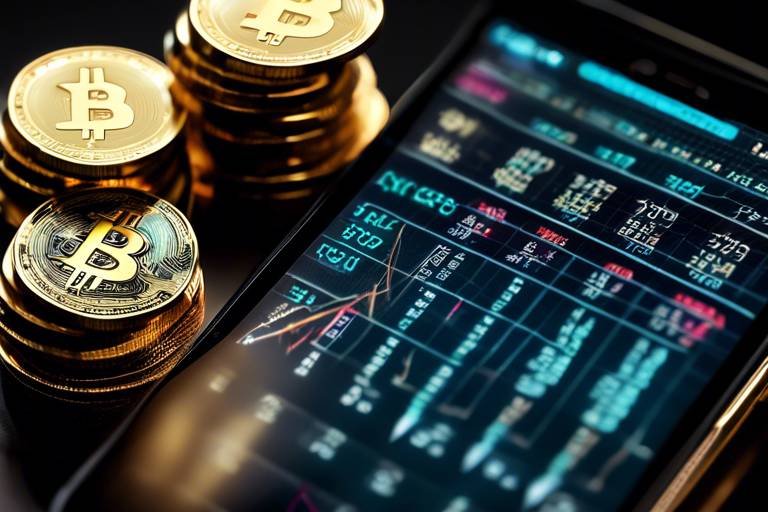Analyzing Recent Trends in DeFi - What to Expect
The world of Decentralized Finance, or DeFi, is evolving at a breakneck pace, and if you blink, you might miss the next big thing. This article dives deep into the latest developments in DeFi, offering insights into future trends, innovations, and the challenges that lie ahead. Buckle up, because the ride through the DeFi landscape is anything but boring!
Layer 2 solutions are like a breath of fresh air in the DeFi ecosystem. They tackle the scalability issues that have plagued many blockchain networks, enhancing transaction speeds and slashing costs. Imagine trying to drive a car in rush hour traffic; it’s slow and frustrating. Now, picture a high-speed train that zooms past all that congestion—this is precisely what Layer 2 solutions do for DeFi. By processing transactions off the main blockchain (Layer 1), they allow for faster and cheaper transactions, which is a game-changer for users and developers alike.
As the DeFi space matures, cross-chain interoperability is becoming a vital component. This technology allows different blockchain networks to communicate and transact with one another seamlessly. Think of it like a universal translator at a global conference—everyone can speak their own language, but they can still understand each other. The protocols and technologies that facilitate this integration are essential for creating a more interconnected DeFi ecosystem.
Bridges and protocols are the unsung heroes of cross-chain interactions. They enable assets to move freely between different blockchains, expanding DeFi's reach and usability. For instance, if you own Bitcoin but want to participate in a DeFi project on Ethereum, bridges allow you to convert your Bitcoin into a token that can be used on the Ethereum network. This is crucial for fostering innovation and expanding the user base in DeFi.
However, with great power comes great responsibility—or in this case, great risk. While bridges provide the connectivity that enhances user experience, they also introduce security vulnerabilities. Imagine a bridge over a river: while it allows easy passage, it can also be a target for attacks. Cross-chain transactions can expose users to risks such as hacks and exploits. It’s essential to highlight the importance of robust security measures to mitigate these risks and ensure user confidence in using these technologies.
Looking ahead, the future of bridge technology is promising. Innovations are on the horizon that aim to improve both security and efficiency. As developers continue to refine these tools, we can expect to see enhanced protocols that not only protect user assets but also streamline the transaction process. The potential effects on the DeFi landscape are significant, paving the way for a more secure and user-friendly environment.
Another fascinating trend in DeFi is the rise of Decentralized Autonomous Organizations (DAOs). These entities are revolutionizing governance by enabling community-driven decision-making. Imagine a company where every employee has a say in the direction it takes—this is what DAOs aim to achieve. They empower users to participate in governance, making the system more democratic and transparent. However, this structure also comes with its own set of challenges, such as the potential for governance attacks and the need for effective voting mechanisms.
Yield farming is another area witnessing rapid evolution. New strategies and platforms are popping up like mushrooms after the rain, each offering unique ways for investors to generate returns on their assets. But, as with any investment, it’s crucial to understand the landscape. Yield farming can be enticing, but it’s essential to navigate the risks and rewards carefully.
Engaging in yield farming is like walking a tightrope; while the rewards can be substantial, the risks are equally significant. Volatility, impermanent loss, and market fluctuations can turn a promising investment into a nightmare. Therefore, participants must educate themselves about these risks to make informed decisions and safeguard their investments.
As DeFi continues to grow, the shadow of regulatory scrutiny looms large. Regulations can shape yield farming practices and the broader DeFi ecosystem, influencing both innovation and compliance. Understanding the regulatory landscape is crucial for developers and investors alike, as it can dictate the viability of certain strategies and platforms.
Stablecoins play an integral role in the DeFi ecosystem, providing much-needed stability in a volatile market. They act as a bridge, allowing users to navigate the turbulent waters of digital assets without losing their footing. As we look ahead, the evolution of stablecoins and their applications in DeFi will be fascinating to observe.
The debate between centralized and decentralized stablecoins is heating up. Centralized stablecoins, backed by fiat currencies, offer stability but come with concerns about trust and control. On the other hand, decentralized stablecoins aim to provide the same stability without relying on a central authority. This section will delve into the advantages, disadvantages, and implications for users and the DeFi ecosystem.
Finally, the adoption of stablecoins is increasing across various sectors, driven by factors such as the need for stable value in transactions and the growing acceptance of cryptocurrencies. This trend is set to have a significant impact on the DeFi market and user behavior, creating new opportunities and challenges.
- What is DeFi? DeFi, or Decentralized Finance, refers to a financial system built on blockchain technology that eliminates intermediaries, allowing for peer-to-peer transactions.
- How do Layer 2 solutions work? Layer 2 solutions operate on top of a blockchain (Layer 1) to improve transaction speed and reduce costs by processing transactions off the main chain.
- What are DAOs? Decentralized Autonomous Organizations (DAOs) are organizations governed by smart contracts, allowing community members to participate in decision-making processes.
- What are the risks of yield farming? Risks include volatility, impermanent loss, and the potential for smart contract failures, making it important for participants to conduct thorough research.
- What role do stablecoins play in DeFi? Stablecoins provide a stable medium of exchange within the DeFi ecosystem, allowing users to transact without the volatility associated with other cryptocurrencies.

The Rise of Layer 2 Solutions
In the fast-paced world of Decentralized Finance (DeFi), one of the most exciting developments has been the emergence of Layer 2 solutions. These innovative technologies are designed to tackle the longstanding issue of scalability that has plagued many blockchain networks. Think of Layer 2 solutions as an express lane on a busy highway; they allow transactions to move faster and more efficiently, reducing congestion on the main road. As the DeFi ecosystem continues to expand, the demand for quicker, cheaper transactions is more pressing than ever.
Layer 2 solutions work by processing transactions off the main blockchain (Layer 1) and then settling them back on the main chain. This not only enhances transaction speeds but also significantly lowers fees, making DeFi more accessible to a broader audience. For instance, platforms like Polygon and Optimism have gained popularity for their ability to facilitate rapid transactions while keeping costs low. This is particularly important for users who engage in frequent trading or yield farming, where high gas fees can eat into profits.
Moreover, the integration of Layer 2 solutions is reshaping the user experience in DeFi. Imagine being able to conduct transactions in real-time without worrying about exorbitant fees or slow confirmation times. This shift is akin to upgrading from a dial-up internet connection to high-speed broadband; it transforms the way users interact with the blockchain. With Layer 2 solutions, users can participate in DeFi protocols with greater ease, leading to increased adoption and engagement.
However, it's essential to understand that while Layer 2 solutions offer numerous benefits, they also come with their own set of challenges. For instance, the reliance on these solutions can create a fragmented ecosystem where users must navigate multiple platforms and protocols. This complexity can be daunting for newcomers to DeFi. Additionally, the security of Layer 2 solutions is a topic of ongoing debate, as they introduce new vectors for potential attacks. As the technology evolves, developers are continually working to enhance security measures to protect users' assets.
In summary, the rise of Layer 2 solutions is a game-changer for the DeFi landscape. They not only address scalability issues but also enhance the overall user experience, making DeFi more appealing to a wider audience. As we look to the future, it's clear that Layer 2 solutions will play a pivotal role in shaping the next phase of decentralized finance. With ongoing innovations and improvements, we can expect to see even more exciting developments in this space.
- What are Layer 2 solutions? Layer 2 solutions are technologies that operate on top of a blockchain (Layer 1) to improve scalability and transaction speeds.
- How do Layer 2 solutions benefit DeFi? They reduce transaction fees and increase processing speed, making DeFi more accessible and efficient for users.
- Are Layer 2 solutions secure? While they offer benefits, they also introduce new security challenges that developers are actively working to address.
- What are some examples of Layer 2 solutions? Popular examples include Polygon and Optimism, which have gained traction in the DeFi ecosystem.

Cross-Chain Interoperability
In the rapidly evolving world of Decentralized Finance (DeFi), is not just a buzzword; it’s becoming a necessity. Imagine a world where different blockchain networks can communicate effortlessly, much like how various social media platforms allow users to share content across them. This seamless interaction is crucial for the growth and adoption of DeFi, as it enables users to access a wider range of services and opportunities without being confined to a single blockchain ecosystem.
The growing demand for cross-chain functionality stems from the limitations of isolated blockchains. Each blockchain operates in its own silo, which can hinder the flow of assets and information. However, with the advent of innovative technologies and protocols, we are witnessing a transformation that promises to bridge these gaps. By enabling assets to move freely between different blockchains, users can take advantage of the unique features offered by each network, whether it’s speed, security, or specific financial products.
Several key technologies are driving this movement towards cross-chain interoperability:
- Atomic Swaps: These allow users to exchange cryptocurrencies from different blockchains without the need for a trusted third party, ensuring that transactions are secure and efficient.
- Wrapped Tokens: By creating tokens that represent assets from one blockchain on another, wrapped tokens facilitate easy transfers and access to DeFi protocols across different networks.
- Inter-Blockchain Communication (IBC): This protocol enables different blockchains to communicate with each other, allowing for the transfer of data and assets seamlessly.
Bridges are at the forefront of this technology, acting as conduits that connect disparate blockchains. They allow assets to be transferred across networks, unlocking new possibilities for users. However, while these bridges enhance functionality, they also introduce security vulnerabilities. As more assets flow across multiple chains, the potential for exploits and hacks increases. Thus, it’s crucial for developers to implement robust security measures to protect users' assets during cross-chain transactions.
Looking ahead, the future of cross-chain interoperability seems promising. Innovations in bridge technology are on the horizon, with advancements aimed at improving both security and efficiency. For example, developers are exploring ways to create more sophisticated smart contracts that can automatically handle the complexities of cross-chain transactions. This could lead to a more user-friendly experience, where anyone can engage in DeFi activities without needing a deep understanding of the underlying technology.
In essence, cross-chain interoperability is set to revolutionize the DeFi landscape. By breaking down the barriers between blockchains, it paves the way for a more inclusive and accessible financial ecosystem. As we continue to witness these developments, it’s clear that the future of DeFi is not just about individual chains but about creating a cohesive network that benefits all users.
- What is cross-chain interoperability? Cross-chain interoperability refers to the ability of different blockchain networks to communicate and transact with each other seamlessly.
- Why is cross-chain interoperability important in DeFi? It allows users to access a broader range of financial services and products, enhancing the overall user experience and promoting innovation.
- What are some technologies that enable cross-chain interoperability? Technologies include atomic swaps, wrapped tokens, and inter-blockchain communication protocols.
- What are the security risks associated with cross-chain transactions? The main risks include potential exploits and hacks due to the complexity of moving assets between different networks.

Bridges and Protocols
In the vibrant world of Decentralized Finance (DeFi), serve as the vital conduits that facilitate interaction between disparate blockchain networks. Imagine the blockchain ecosystem as a bustling city, where each blockchain represents a unique neighborhood. Just like how bridges connect different parts of a city, these technological innovations allow users to transfer assets and information seamlessly across various platforms. This interconnectedness is crucial for enhancing the overall functionality and accessibility of DeFi applications.
Bridges operate by locking assets on one blockchain and minting equivalent tokens on another, effectively creating a two-way street for value transfer. For instance, if you want to move your assets from Ethereum to Binance Smart Chain, a bridge will lock your Ethereum tokens and issue you a corresponding amount of tokens on Binance Smart Chain. This process not only enables cross-chain transactions but also opens up a plethora of opportunities for liquidity and investment across multiple platforms.
Moreover, protocols such as Wrapped Tokens and Atomic Swaps are essential components of this cross-chain interaction. Wrapped tokens, like Wrapped Bitcoin (WBTC), allow Bitcoin to be used on the Ethereum network, enhancing liquidity for decentralized applications (dApps). On the other hand, atomic swaps enable users to exchange cryptocurrencies across different blockchains without the need for a centralized exchange, ensuring a trustless and secure transaction process.
However, while bridges and protocols enhance the DeFi ecosystem's functionality, they also come with their own set of challenges. The complexity of these systems can lead to potential vulnerabilities, making them attractive targets for malicious actors. For instance, if a bridge is compromised, it could lead to significant financial losses for users. Therefore, developers are continuously working on improving the security measures surrounding these technologies to mitigate risks.
To illustrate the impact of bridges and protocols, consider the following table that summarizes some of the most notable ones in the DeFi landscape:
| Bridge/Protocol | Functionality | Key Features |
|---|---|---|
| Wrapped Bitcoin (WBTC) | Bridges Bitcoin to Ethereum | ERC-20 token, high liquidity |
| RenVM | Cross-chain asset transfer | Decentralized, trustless |
| Thorchain | Cross-chain liquidity | Automated market maker, native asset swaps |
In conclusion, bridges and protocols are not just technical constructs; they are the lifelines of the DeFi ecosystem, enabling users to navigate the complex landscape of blockchain technology. As we continue to witness the evolution of these tools, their importance in fostering a more interconnected and efficient DeFi environment cannot be overstated. Understanding how these systems work and their implications for security and usability is essential for anyone looking to engage with DeFi.
- What are bridges in DeFi? Bridges are technologies that allow for the transfer of assets between different blockchain networks, enhancing interoperability.
- How do wrapped tokens work? Wrapped tokens are created by locking an asset on its native blockchain and issuing an equivalent token on another blockchain.
- What are the security risks associated with using bridges? Bridges can be vulnerable to hacks, which may lead to significant financial losses. Continuous security improvements are necessary to mitigate these risks.

Security Concerns
As the DeFi landscape continues to flourish, the security of cross-chain transactions has emerged as a significant concern. While bridges facilitate the seamless movement of assets between different blockchains, they also introduce a myriad of vulnerabilities that can be exploited by malicious actors. Imagine a bustling marketplace where the stalls are connected by narrow bridges; if those bridges are weak or poorly constructed, the entire marketplace could be at risk of collapse. This analogy reflects the precarious nature of cross-chain interactions in DeFi.
One of the primary risks associated with these bridges is the potential for smart contract exploits. Many bridges rely on complex smart contracts to manage the locking and minting of assets across chains. If there are flaws in the code, hackers can exploit these vulnerabilities to drain funds. In fact, several high-profile hacks have occurred due to vulnerabilities in these contracts, resulting in millions of dollars lost. According to a recent report, over $1 billion was stolen from DeFi platforms in 2022 alone, highlighting the critical need for robust security measures.
Moreover, the decentralized nature of DeFi means that there is often no centralized authority to turn to in case of a breach. This lack of oversight can leave users feeling vulnerable and uncertain about the safety of their assets. To mitigate these risks, developers and users alike must prioritize security audits and engage with reputable projects that have a proven track record. The adoption of multi-signature wallets and insurance protocols can also serve as layers of protection against potential losses.
In addition to smart contract exploits, users must also be aware of phishing attacks and other social engineering tactics that aim to compromise their private keys. As users interact with various platforms and bridges, they become targets for scammers who employ deceptive tactics to steal sensitive information. Therefore, maintaining a healthy level of skepticism and exercising caution while sharing personal information is paramount.
Ultimately, the future of cross-chain interoperability in DeFi hinges on the community's ability to address these security concerns effectively. As developers innovate and create more sophisticated solutions, the focus on security must remain at the forefront. The evolution of security protocols, such as zero-knowledge proofs and multi-party computation, holds promise for enhancing the safety of cross-chain transactions. By prioritizing security, the DeFi ecosystem can continue to grow and evolve without compromising user trust.
- What are the main security risks in DeFi? The main risks include smart contract vulnerabilities, phishing attacks, and lack of oversight.
- How can users protect themselves in DeFi? Users can protect themselves by using multi-signature wallets, engaging with audited projects, and being cautious with personal information.
- What is a smart contract exploit? A smart contract exploit occurs when hackers take advantage of vulnerabilities in the code of a smart contract to steal assets.
- What role do audits play in DeFi security? Audits help identify and rectify vulnerabilities in smart contracts before they can be exploited, enhancing overall security.

Future Developments
As we gaze into the crystal ball of decentralized finance (DeFi), it's clear that the landscape is not static; it’s a dynamic arena characterized by rapid innovation and evolution. One of the most exciting prospects on the horizon is the advancement of bridge technologies, which are set to revolutionize the way we interact with multiple blockchain networks. Imagine a world where transferring assets across different blockchains is as seamless as sending an email. This is not just a dream—it's becoming a reality.
Future developments in bridge technology will likely focus on enhancing security and efficiency. Currently, many bridges face challenges related to vulnerabilities that can be exploited by malicious actors. However, emerging solutions are being designed to incorporate advanced cryptographic techniques and decentralized validation processes. This means that as these technologies mature, we can expect a significant reduction in the risks associated with cross-chain transactions.
Moreover, the integration of layer 2 solutions with cross-chain bridges is another trend to watch. By leveraging the scalability benefits of layer 2 protocols, bridges will not only facilitate faster transactions but also lower costs. This dual benefit could lead to a surge in user adoption, as more individuals and businesses look to take advantage of the cost-effective and speedy transactions that DeFi has to offer.
In addition to technological advancements, we can anticipate a shift in regulatory frameworks surrounding DeFi. As the sector matures, regulatory bodies are beginning to take notice. This could lead to the establishment of clearer guidelines that will foster innovation while ensuring user protection. The evolution of compliance measures will likely create a safer environment for participants, subsequently attracting more institutional investors to the space.
As we look at the potential for future developments, it’s also essential to consider the role of community-driven initiatives. Decentralized Autonomous Organizations (DAOs) are paving the way for governance structures that empower users. These organizations can play a crucial role in shaping the future of DeFi by allowing stakeholders to vote on critical decisions, from protocol upgrades to fund allocations. This participatory approach not only enhances transparency but also fosters a sense of ownership among users.
In summary, the future of DeFi is poised for transformative changes driven by technological advancements, regulatory clarity, and community engagement. As these elements converge, we can expect a more robust, secure, and user-friendly ecosystem that will attract a broader audience. The next few years could very well define the trajectory of DeFi, making it an exciting time for investors, developers, and users alike.
- What are bridges in DeFi? Bridges are protocols that facilitate the transfer of assets and data between different blockchain networks, enhancing interoperability.
- How do layer 2 solutions improve DeFi? Layer 2 solutions enhance scalability, allowing for faster transactions and reduced fees, which improves user experience in DeFi applications.
- What role do DAOs play in DeFi? DAOs enable community-driven governance, allowing users to participate in decision-making processes regarding the direction and operations of DeFi protocols.
- Are there risks associated with using bridges? Yes, while bridges enhance connectivity, they can also introduce security vulnerabilities that users should be aware of.

Decentralized Autonomous Organizations (DAOs)
In the rapidly evolving world of Decentralized Finance (DeFi), have emerged as a transformative force. These organizations operate on blockchain technology, allowing them to function without a central authority. Imagine a community where every member has a voice, and decisions are made collectively through transparent voting mechanisms. That's the essence of a DAO! By leveraging smart contracts, DAOs automate processes and ensure that governance is not only democratic but also efficient.
One of the most exciting aspects of DAOs is their ability to empower individuals. Members can propose changes, vote on initiatives, and even allocate funds for projects that benefit the community. This structure fosters a sense of ownership and responsibility among participants, as everyone has a stake in the outcomes. However, it's not all sunshine and rainbows; DAOs face challenges, particularly concerning decision-making efficiency and the potential for governance attacks. Imagine a scenario where a small group of members could sway decisions in their favor—this risk is very real and highlights the need for robust governance frameworks.
To truly grasp the impact of DAOs in the DeFi landscape, let's explore some of their key advantages:
- Transparency: All transactions and decisions are recorded on the blockchain, making them publicly accessible and verifiable.
- Global Participation: Anyone with an internet connection can join and contribute to a DAO, breaking down geographical barriers.
- Community-Driven: DAOs allow for a more democratic approach to governance, where each member's voice can influence outcomes.
Despite these advantages, DAOs also encounter significant hurdles. For instance, the lack of legal recognition in many jurisdictions can create uncertainty for participants. Furthermore, the technical complexity of participating in a DAO can deter less tech-savvy individuals. As the DeFi ecosystem continues to mature, addressing these challenges will be crucial for the widespread adoption of DAOs.
As we look to the future, it's clear that DAOs will play a pivotal role in shaping the governance structures of DeFi projects. With advancements in technology and growing interest from investors, we can expect to see more innovative DAOs emerging. These organizations will not only enhance user engagement but also redefine what it means to be a part of a financial ecosystem. The question remains: will DAOs become the standard for governance in DeFi, or will traditional models persist? Only time will tell!
- What is a DAO? A DAO is a decentralized organization that operates through smart contracts on a blockchain, allowing members to participate in governance and decision-making.
- How do DAOs make decisions? Members propose changes or initiatives, and decisions are made through voting mechanisms, ensuring that every voice is heard.
- What are the risks associated with DAOs? Risks include governance attacks, inefficiencies in decision-making, and a lack of legal recognition in certain jurisdictions.
- Can anyone join a DAO? Yes! Typically, anyone with an internet connection can participate in a DAO, although some may require specific tokens for membership.

Yield Farming Evolution
Yield farming has taken the world of Decentralized Finance (DeFi) by storm, evolving from simple liquidity provision to intricate strategies that maximize returns. This transformation is akin to a gardener tending to their plants, carefully selecting which seeds to sow for the best harvest. In the DeFi landscape, these "seeds" are various tokens and liquidity pools that yield returns based on user engagement and market dynamics. As more platforms emerge, the competition intensifies, leading to innovative strategies that attract both seasoned investors and newcomers alike.
In its early days, yield farming primarily revolved around providing liquidity to decentralized exchanges (DEXs) in exchange for governance tokens or transaction fees. However, the landscape has shifted dramatically, introducing a plethora of platforms and strategies that cater to different risk appetites and investment goals. For instance, some investors might prefer stable, low-risk options, while others may chase higher yields at the risk of greater volatility. This evolution has made yield farming a dynamic arena where participants must stay informed and agile.
One of the most significant trends in yield farming is the emergence of automated yield aggregators. These platforms, like Yearn.finance and Harvest Finance, automate the process of yield farming by dynamically shifting funds between various liquidity pools to maximize returns. Imagine having a personal financial advisor who constantly monitors the market for the best investment opportunities—this is precisely what these aggregators do. They analyze yields across multiple platforms and make real-time adjustments to ensure that users receive the best possible returns on their investments.
However, with great opportunity comes great risk. The volatility inherent in yield farming can lead to substantial losses, particularly in the form of impermanent loss. This occurs when the price of tokens in a liquidity pool diverges significantly, resulting in lower returns compared to simply holding the tokens. Therefore, participants must weigh their options carefully, considering both the potential rewards and the associated risks. The landscape is akin to a high-stakes poker game, where understanding the odds can mean the difference between winning and losing.
Moreover, regulatory scrutiny is becoming an increasingly important factor in the evolution of yield farming. As governments worldwide begin to understand the implications of DeFi, they are starting to implement regulations that could impact how yield farming operates. This regulatory landscape will likely shape the future of yield farming, influencing both innovation and compliance. For instance, platforms may need to adopt stricter KYC (Know Your Customer) measures, which could deter some users but enhance the overall security and legitimacy of the ecosystem.
As we look to the future, the evolution of yield farming will continue to unfold, driven by technological advancements and user demand. New strategies will emerge, and the tools available to farmers will become more sophisticated. Just like a tech-savvy farmer using the latest gadgets to optimize their yield, DeFi participants will leverage cutting-edge technology to enhance their investment strategies. The question remains: how will these innovations affect the landscape of yield farming, and what new opportunities will arise for those willing to navigate this exciting but complex terrain?
- What is yield farming? Yield farming is a method of earning rewards on cryptocurrency holdings by providing liquidity to decentralized finance platforms.
- What are the risks associated with yield farming? Risks include impermanent loss, smart contract vulnerabilities, and regulatory scrutiny.
- How do automated yield aggregators work? They automatically shift funds between different liquidity pools to maximize returns based on real-time market analysis.
- Can yield farming be profitable? Yes, but profitability depends on various factors, including market conditions, chosen strategies, and associated risks.

Risks and Rewards
Yield farming, while offering the tantalizing prospect of high returns, is not without its pitfalls. Just like a roller coaster, the thrill comes with its fair share of risks that can leave investors feeling dizzy. Understanding these risks and rewards is essential for anyone looking to dive into this exciting yet volatile space. So, what are the main risks associated with yield farming?
First off, the most significant risk is the inherent volatility of cryptocurrencies. Prices can fluctuate wildly in a matter of hours, which can lead to substantial losses for investors. Imagine holding onto a crypto asset that suddenly drops 30% overnight—it's a gut-wrenching experience! This volatility is often exacerbated in yield farming, where assets are frequently moved between different platforms and liquidity pools, amplifying the potential for loss.
Another major concern is impermanent loss. This occurs when the price of tokens in a liquidity pool diverges significantly from their original price at the time of deposit. The result? You could end up with less value than if you had simply held onto your tokens. To illustrate, consider the following scenario:
| Token Price at Deposit | Token Price After 1 Month | Value Lost vs. Holding |
|---|---|---|
| $100 | $150 | $50 |
| $100 | $50 | $100 |
In this table, you can see how drastic price changes can lead to significant losses, especially if you had opted for yield farming instead of simply holding your tokens. This is a stark reminder that while the potential for profit exists, so does the risk of losing money.
Moreover, yield farming often involves interacting with smart contracts, which, while revolutionary, are not foolproof. Bugs or vulnerabilities in these contracts can lead to loss of funds. In fact, several high-profile hacks have occurred in the DeFi space due to poorly coded smart contracts. As an investor, you must ask yourself: how much do you trust the technology behind the platform you’re using?
But let’s not forget the rewards. Yield farming can offer lucrative returns that far exceed traditional investment avenues. Many platforms offer annual percentage yields (APYs) that can reach upwards of 100% or more! However, it’s crucial to approach these numbers with a healthy dose of skepticism. High returns often come with high risks, and it’s essential to do your due diligence before jumping in.
In summary, yield farming presents a complex landscape of risks and rewards. While the potential for significant profits exists, so do the dangers of volatility, impermanent loss, and smart contract vulnerabilities. As you navigate this thrilling world, remember to weigh your options carefully and consider your risk tolerance. After all, in the world of DeFi, knowledge is not just power—it’s your safety net.
- What is yield farming? Yield farming is a way to earn rewards by providing liquidity to DeFi protocols, often through lending or staking your crypto assets.
- What are the main risks of yield farming? The main risks include volatility, impermanent loss, and potential smart contract vulnerabilities.
- How can I minimize risks in yield farming? Diversifying your investments, researching platforms thoroughly, and only investing what you can afford to lose can help minimize risks.
- Are the rewards worth the risks? This depends on your risk appetite and investment strategy. High rewards come with high risks, so it’s crucial to do your homework.

Regulatory Impacts
As Decentralized Finance (DeFi) continues to gain momentum, the regulatory landscape is evolving at a breakneck pace. This evolution poses both challenges and opportunities for developers, investors, and users alike. Regulatory scrutiny is intensifying, driven by concerns over fraud, market manipulation, and the potential for significant financial losses in an unregulated environment. Investors are becoming increasingly aware of the risks associated with DeFi, and as a result, regulators are stepping in to provide clearer guidelines.
One of the most pressing issues is the need for compliance. Regulatory bodies across the globe are beginning to establish frameworks that govern how DeFi platforms operate. These frameworks often focus on anti-money laundering (AML) and know your customer (KYC) regulations, which can significantly impact how DeFi projects are structured. For instance, projects that previously operated under a decentralized ethos may now need to implement KYC procedures that require users to verify their identities, potentially undermining the very principles of anonymity and decentralization that DeFi was built upon.
Furthermore, the implications of regulation extend beyond just compliance. They can also influence the innovation landscape within DeFi. While some argue that regulation stifles creativity and slows down progress, others believe that a regulated environment can foster trust and attract institutional investors. This dichotomy raises the question: will regulation help or hinder the growth of DeFi?
To illustrate the potential impacts of regulation on DeFi, consider the following table that outlines key areas of concern:
| Area of Concern | Impact on DeFi |
|---|---|
| Compliance Costs | Increased operational costs for DeFi platforms to meet regulatory standards. |
| Market Access | Potential barriers for new entrants due to stringent regulations. |
| Investor Confidence | Enhanced trust from institutional investors, leading to increased capital flow. |
| Innovation Stifling | Risk of slowing down the pace of innovation as projects navigate regulatory hurdles. |
In addition to these immediate impacts, the regulatory environment will likely shape the future of yield farming and other DeFi activities. For instance, regulations may dictate how yield farming strategies are structured, potentially limiting the types of assets that can be used or the returns that can be offered. This could lead to a more stable, albeit less lucrative, yield farming landscape.
Moreover, as regulators become more familiar with DeFi, we can expect a more nuanced approach to regulation. Authorities may develop tailored regulations that recognize the unique characteristics of DeFi, rather than applying traditional financial regulations that may not be suitable. This could lead to a more balanced ecosystem where innovation can thrive alongside necessary protections for investors.
In summary, the regulatory impacts on DeFi are profound and multifaceted. While the landscape is fraught with challenges, it also presents opportunities for growth and maturation. As stakeholders navigate this evolving terrain, the key will be to find a balance between innovation and regulation—ensuring that DeFi can continue to flourish while safeguarding the interests of users and investors alike.
- What is the primary purpose of DeFi regulations? The main goal is to protect investors and maintain market integrity while fostering innovation.
- How will regulations affect my ability to participate in DeFi? Regulations may require additional verification steps, but they can also enhance security and trust in the ecosystem.
- Are all DeFi projects subject to the same regulations? No, regulations can vary significantly by country and the specific nature of the project.

Future of Stablecoins in DeFi
Stablecoins are becoming the backbone of the Decentralized Finance (DeFi) ecosystem, providing a much-needed layer of stability in a market characterized by extreme volatility. As we look to the future, it’s clear that stablecoins will continue to evolve, adapting to the changing demands of users and the broader financial landscape. But what exactly does this future hold? Let’s dive into some key aspects that will shape the role of stablecoins in DeFi.
One of the most significant trends is the increasing adoption of stablecoins across various sectors, including e-commerce, remittances, and even traditional finance. This is largely driven by their ability to offer a stable medium of exchange, which is crucial for users who are wary of the price fluctuations commonly associated with cryptocurrencies. In fact, many businesses are beginning to accept stablecoins as a form of payment, recognizing their potential to streamline transactions and reduce costs.
Moreover, the competition between centralized and decentralized stablecoins is heating up. Centralized stablecoins, like Tether (USDT) and USD Coin (USDC), are backed by fiat reserves and are easier to integrate into existing financial systems. On the other hand, decentralized stablecoins, such as DAI, operate without a central authority, offering users more control and transparency. The debate between these two types of stablecoins is not just theoretical; it has real implications for users and the DeFi ecosystem as a whole. For instance, centralized stablecoins may face regulatory scrutiny, while decentralized alternatives could struggle with maintaining peg stability.
To illustrate the differences between these two types of stablecoins, consider the following table:
| Feature | Centralized Stablecoins | Decentralized Stablecoins |
|---|---|---|
| Backing | Fiat reserves | Collateralized or algorithmic mechanisms |
| Control | Central authority | Community governance |
| Transparency | Audited by third parties | On-chain verifiable |
| Regulatory Risk | Higher | Lower |
As stablecoins gain traction, we can also expect to see innovative financial products emerge that leverage these assets. For instance, lending platforms may start to offer more competitive interest rates for stablecoin deposits, attracting users who seek yield without the risks associated with more volatile cryptocurrencies. Additionally, automated market makers (AMMs) could integrate stablecoins to create more efficient liquidity pools, further enhancing their utility within the DeFi space.
However, with great potential comes great responsibility. The future of stablecoins in DeFi is not without challenges. Regulatory frameworks are still evolving, and how governments choose to regulate stablecoins could significantly impact their adoption and functionality. As authorities worldwide scrutinize these assets, it’s crucial for the DeFi community to engage in discussions about compliance and transparency to foster a sustainable ecosystem.
In conclusion, the future of stablecoins in DeFi is incredibly promising but fraught with complexities. As we move forward, the interplay between centralized and decentralized stablecoins, regulatory developments, and innovative financial products will shape their trajectory. Users and developers alike must stay informed and adaptable to navigate this exciting yet unpredictable landscape.
- What are stablecoins? Stablecoins are cryptocurrencies that are pegged to stable assets, such as fiat currencies, to minimize price volatility.
- Why are stablecoins important in DeFi? They provide stability, making transactions more predictable and reliable, which is crucial for users who want to avoid volatility.
- What is the difference between centralized and decentralized stablecoins? Centralized stablecoins are controlled by a central authority and backed by reserves, while decentralized stablecoins operate without a central authority and use smart contracts to maintain their value.
- How do regulatory changes affect stablecoins? Regulatory scrutiny can impact the adoption and functionality of stablecoins, influencing how they are integrated into existing financial systems.

Centralized vs. Decentralized Stablecoins
When it comes to stablecoins, the debate between centralized and decentralized options can be quite heated. Both types serve the purpose of providing stability in the volatile world of cryptocurrencies, but they do so in fundamentally different ways. Centralized stablecoins, such as Tether (USDT) and USD Coin (USDC), are typically backed by reserves held in a bank account. This means that for every coin issued, there is a corresponding amount of fiat currency or equivalent assets held in reserve. The key advantage here is that users can easily trust these stablecoins due to their backing by traditional financial institutions. However, this reliance on centralized entities can also be seen as a vulnerability, as it introduces risks related to transparency and regulatory scrutiny.
On the other hand, decentralized stablecoins like DAI operate on blockchain technology without the need for a central authority. Instead of being backed by fiat currency, these stablecoins are often collateralized by other cryptocurrencies. For instance, DAI is generated through over-collateralization of assets like Ethereum. This model provides a level of transparency and autonomy that appeals to many users in the DeFi space. However, it also comes with its own set of challenges, particularly in terms of price stability and the mechanisms used to maintain it. For example, if the value of the collateral falls significantly, it can lead to a situation where the stablecoin becomes under-collateralized, risking its peg to the dollar.
To further illustrate the differences between these two types of stablecoins, let's take a look at the following table:
| Feature | Centralized Stablecoins | Decentralized Stablecoins |
|---|---|---|
| Backing | Fiat reserves held by a central authority | Cryptocurrency collateral |
| Transparency | Can be opaque; depends on audits | Transparent; operates on blockchain |
| Regulatory Risk | High; subject to government regulations | Lower; operates independently |
| Stability Mechanism | Redeemable for fiat currency | Algorithmic or collateral-based |
In summary, the choice between centralized and decentralized stablecoins often boils down to personal preference and risk tolerance. Centralized stablecoins offer the comfort of traditional finance but come with regulatory risks and potential for lack of transparency. Conversely, decentralized stablecoins provide a more transparent and autonomous option but can face challenges in maintaining their stability. As the DeFi landscape continues to evolve, the future of stablecoins will likely see innovations that may blur the lines between these two categories.
- What is a stablecoin? A stablecoin is a type of cryptocurrency designed to maintain a stable value, often pegged to a fiat currency like the US dollar.
- Why are centralized stablecoins considered risky? Centralized stablecoins rely on a central authority for their backing, which can lead to transparency issues and regulatory scrutiny.
- How do decentralized stablecoins maintain their value? Decentralized stablecoins use mechanisms like over-collateralization and algorithms to maintain their peg to fiat currencies.
- Can I convert stablecoins back to fiat? Yes, centralized stablecoins can typically be redeemed for fiat currency, while decentralized stablecoins may require additional steps.

Adoption Trends
The adoption of stablecoins in the DeFi ecosystem is witnessing a remarkable surge, driven by various factors that highlight their utility and appeal. As the digital economy evolves, stablecoins have emerged as a crucial bridge between traditional finance and the burgeoning world of decentralized finance. Their ability to offer stability in a typically volatile market makes them particularly attractive to both individual and institutional investors.
One of the primary reasons for the increasing adoption of stablecoins is the growing demand for liquidity. As more users flock to DeFi platforms, the need for stable assets that can facilitate transactions without the fear of drastic price swings becomes essential. In fact, many DeFi protocols now exclusively utilize stablecoins for lending, borrowing, and yield farming, creating a robust ecosystem that thrives on these digital assets.
Moreover, the integration of stablecoins into various sectors is becoming more pronounced. Businesses are recognizing the potential of stablecoins for cross-border transactions, enabling faster and cheaper transfers compared to traditional banking systems. For instance, companies in the remittance industry are increasingly adopting stablecoins to streamline their operations and reduce costs. This trend is not only limited to remittances; e-commerce platforms are also exploring stablecoin payments, enhancing their appeal to tech-savvy consumers.
To further illustrate the adoption trends, consider the following key statistics:
| Year | Stablecoin Market Cap (in Billion USD) | Number of Active Users |
|---|---|---|
| 2020 | 5 | 1 Million |
| 2021 | 40 | 5 Million |
| 2022 | 100 | 10 Million |
| 2023 | 160 | 20 Million |
This table demonstrates the exponential growth of the stablecoin market, reflecting a broader trend of increasing adoption among users. As we move forward, the factors driving this trend will likely continue to evolve. For instance, the rise of decentralized applications (dApps) and the growing acceptance of cryptocurrencies in everyday transactions are expected to further bolster stablecoin usage.
However, it's important to note that the adoption of stablecoins is not without its challenges. Regulatory scrutiny is increasing, with governments around the world seeking to understand and manage the implications of these digital assets. The balance between fostering innovation and ensuring consumer protection will be critical in shaping the future landscape of stablecoins within DeFi.
As we navigate this dynamic environment, one thing is clear: stablecoins are not just a passing trend; they are rapidly becoming a fundamental component of the DeFi ecosystem. Their ability to provide stability, liquidity, and accessibility will continue to attract users from various sectors, cementing their role in the future of finance.
- What are stablecoins? Stablecoins are cryptocurrencies designed to maintain a stable value by pegging them to a reserve of assets, such as fiat currencies or commodities.
- Why are stablecoins important in DeFi? They provide stability in a volatile market, facilitating transactions, lending, and borrowing without the risk of significant price fluctuations.
- What are the risks associated with stablecoins? Risks include regulatory scrutiny, reliance on the backing assets, and potential security vulnerabilities in the platforms that support them.
- How can I buy stablecoins? Stablecoins can be purchased on various cryptocurrency exchanges, often using fiat currency or other cryptocurrencies.
Frequently Asked Questions
- What are Layer 2 solutions in DeFi?
Layer 2 solutions are technologies built on top of existing blockchain networks to improve scalability and transaction speeds. They help reduce costs and enhance user experience, making DeFi applications more accessible and efficient.
- How does cross-chain interoperability benefit DeFi?
Cross-chain interoperability allows different blockchain networks to communicate and transact seamlessly. This capability broadens the DeFi ecosystem by enabling users to access a wider range of assets and services across various platforms.
- What are bridges and protocols in the context of DeFi?
Bridges are tools that connect two different blockchain networks, facilitating the transfer of assets between them. Protocols are the rules and standards that govern these interactions, ensuring security and efficiency in cross-chain transactions.
- What are the security concerns related to cross-chain transactions?
While bridges enhance connectivity, they also introduce security vulnerabilities, such as the risk of hacks and exploits. It's essential to implement robust security measures to protect assets during cross-chain transactions.
- What is a Decentralized Autonomous Organization (DAO)?
A DAO is an organization represented by rules encoded as a computer program that is transparent, controlled by organization members, and not influenced by a central government. DAOs empower community-driven decision-making, reshaping governance in DeFi.
- How is yield farming evolving in the DeFi space?
Yield farming is constantly evolving with new strategies and platforms emerging. Participants are exploring innovative ways to generate returns, but it's crucial to understand the associated risks and rewards before diving in.
- What risks should I be aware of when engaging in yield farming?
Some risks include market volatility, impermanent loss, and smart contract vulnerabilities. It's vital to research thoroughly and assess your risk tolerance before participating in yield farming.
- How do regulations impact DeFi and yield farming?
As DeFi grows, regulatory scrutiny increases. Regulations can shape yield farming practices, influencing innovation and compliance, which may affect both developers and investors in the ecosystem.
- What role do stablecoins play in DeFi?
Stablecoins provide stability in a volatile market, acting as a bridge between traditional finance and DeFi. They facilitate transactions and serve as a reliable store of value within the ecosystem.
- What is the difference between centralized and decentralized stablecoins?
Centralized stablecoins are backed by reserves held by a central entity, while decentralized stablecoins rely on algorithms and smart contracts to maintain their value. Each has its advantages and disadvantages, impacting user trust and the broader DeFi landscape.
- What factors are driving the adoption of stablecoins?
Factors include the need for price stability, ease of transactions, and growing acceptance across various sectors. This trend is significantly impacting user behavior and the overall DeFi market.



















